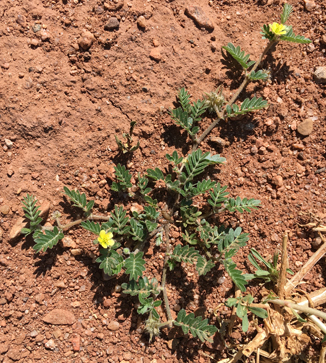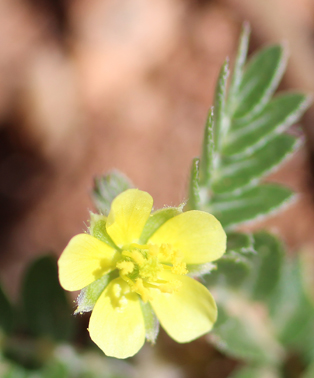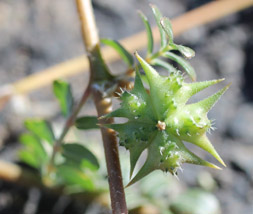
Location
On church base (N35D32'59.610 X W105D41'20.928)
Flowers first observed: 7/7/17
The Plant w/Flowers

The Flower

The Fruit

Distribution
"It is native to warm temperate and tropical regions of the Old World in southern Europe, southern Asia, throughout Africa, and Australia.[8] It can thrive even in desertclimates and poor soil. A network of fine rootlets arise from the taproot to take advantage of soil moisture, by which the plant can survive in very arid conditions.[2]" (Wikipedia)
Description
"Growth pattern The stems radiate from the crown to a diameter of about 10 cm (3.9 in) to over 1 m (3 ft 3 in), often branching. They are usually prostrate, forming flat patches, though they may grow more upwards in shade or among taller plants.
Leaves and stem Stems branch from the crown and are densely hairy.[2] Leaves are opposite and pinnately compound.[2] Densely hairy leaflets are opposite and up to 3 mm (0.12 in) long.[2]
Inflorescence The flowers are 4–10 mm (0.16–0.39 in) wide, with five lemon-yellow petals, five sepals, and ten stamens.[2] In Southern California, it blooms from April through October, where it is highly invasive in waste places and disturbed sites.[2]" (Wikipedia)
Ethnobotanical Uses
Food:
"The spine-covered fruit should be eaten with caution." (WebMD)
Medicine:
Indian Medicine
Siddha - In Siddha medicine, Tribulus terrestris is known in Tamil as Nerunjil, yanai vanangi, thirikandam, siru nerunjil. This whole plant is used in the form of decoction to treat urinary tract infections, urolithiasis, dysmenorrhea, edema.
Ayurveda - In Ayurvedic pharmacology, tribulus terrestris is used as a powder form of the aerial parts, particularly the fruits, and it is known in Sanskrit as gokshura, meaning the "cow's hoof", possibly because the small thorns tend to get stuck on grazing animals. Nevertheless, an unrelated plant, pedalium is also known as gokshura, more specifically as bada gokshura ("big cow's hoof"), whereas the gokshura proper is referred to as chhota gokshura ("small cow's hoof"). The two herbs are often found mixed in powder blends used.[13]
Gokshura is believed to contribute to overall physical, as well as sexual, strength by building all the tissues, especially shukra dhatu (reproductive tissue) but it is not considered as a particular vajikarana (sexual functions) herb.[14] It is believed to be useful in kidney, bladder, urinary tract and uro-genital related conditions, where it is said to act as a diuretic.[15]
Unani - Tribulus terrestris is used in Unani under the Urdu name Khar-e-Khasak Khurd and the pedalium is referred to as Khar-e-Khasak Kalan. Their administration and indications are essentially similar with Ayurveda.
Kashmiri - Tribulus terrestris is called Mitser Kaend (kund singular) in Kashmiri. They are used as a diuretic. A tea made out of them is given to treat fevers of all kinds.
Traditional Chinese Medicine
In traditional Chinese medicine Tribulus terrestris is known under the name bai ji li (白蒺藜). Tribulus terrestris known as ci ji li (刺蒺藜).[16] "Confusion with Astragali complanati Semen (sha yuan zi) originally known as white ji li (白蒺藜 bai ji li), led some writers to attribute tonifying properties to this herb ..."
Dietary supplement
Some body builders use T. terrestris extract as a dietary supplement with the belief that it increases testosterone levels. The belief was popularized by the American bodybuilder Jeffrey Petermann in the early 1970s. However, T. terrestris has failed to increase testosterone levels in controlled studies.[17][18][19] It has also failed to demonstrate strength-enhancing properties,[20] a finding indicating that the purported anabolic steroid effects of Tribulus terrestris are untrue." (Wikipedia)
Internet Links